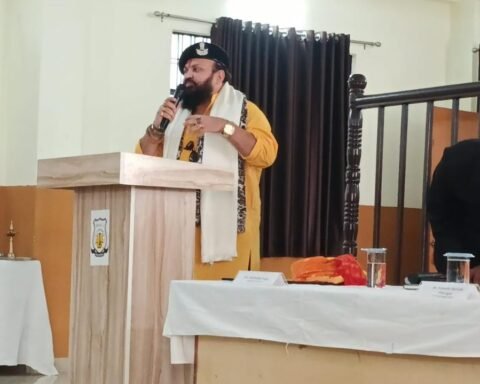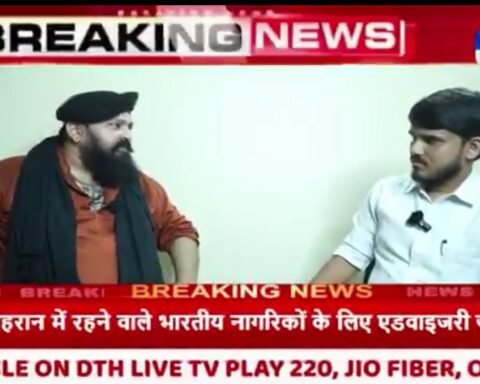New Delhi, Sept. 16, 2025 — Famous Indian Air Force officer Wing Commander Pushkal Vijay Dwivedi (R) unveiled a sweeping framework he calls “Network-Centric Politics,” arguing that the real battleground of 21st-century power is no longer confined to parliaments, media studios, or even the ballot box—but to the webs of interconnected actors that shape perception, policy, and outcomes in real time.
Dwivedi, a defence analyst and think tank, who is voluntarily working with high-level government organizations like DRDO, Ministry of Defence serves as Director General of the Bhartiya Shiksha Anusandhan Parishad and Chief of the Kalki Sena. He is credited as the “Father of Self-Defence Science” and the inventor of analytical protocols—Vijay Code and the PRISM Psychological Analysis System—tools he says help decode threat patterns, information flows, and human-factor vulnerabilities across civil and military contexts.
Presenting his concept in Delhi this week, Wing Commander Pushkal Dwivedi positioned Network-Centric Politics (NCP) as an adaptation of the armed forces’ network-centric warfare ethos to the political arena. “What wins modern air or land battles is shared situational awareness, fast decision cycles, and synchronized action across distributed units,” he noted. “Politics today is no different—except your ‘units’ are business lobbies, social media influencers, NGOs, bureaucracies, intelligence channels, community leaders, and global institutions.”
According to Dwivedi, NCP maps political power as a living network spanning businessmen and industrialists, NGOs and social workers, influencers and media, bureaucrats, intelligence and military leadership, ideological mentors and religious figures, along with multilateral institutions such as the World Bank, IMF, and NATO. The model argues that these nodes collaborate or collide via information flows, financial leverage, regulatory triggers, legal tools, and narrative warfare—often faster than legacy institutions can register.
At the heart of his framework are three accelerants:
- Information Dominance: Control of data, distribution, and attention—whether through algorithmic reach, news cycles, or closed-group messaging—determines whose reality prevails.
- Psychological Operations: Precision messaging, symbolism, and emotional cues—what Dwivedi’s PRISM system classifies as “motivation vectors”—shift behavior without visible coercion.
- Institutional Handoffs: Cross-domain plays (legal, financial, diplomatic, security) reinforce each other: a media narrative primes a regulatory probe; a think-tank paper legitimizes a vote; a rating action tightens capital; an alliance signal deters escalation.
Dwivedi’s NCP concept manual, as described by his team, is a rule-book for designing such cross-domain “handoffs” under time pressure, where he has also suggested a profiling framework that clusters audiences by psychological drivers—status, security, identity, grievance, and aspiration—then matches them to messages and messengers embedded in the network.
The paper situates the United States as an early exemplar of NCP mechanics: military-industrial linkages, Big Tech platforms, think-tank ecosystems, and alliance networks produce outsized agenda-setting power. It cites the migration of influence from traditional media to algorithmic targeting, the politicization of intelligence controversies, and the securitization of information (from election interference debates to platform governance) as evidence of “networks shaping outcomes beyond formal institutions.”
For India, Dwivedi outlines a dual challenge: external network pressures—terror proxies, diaspora activism, sanctions-style finance, and disinformation—combined with internal contests among party machinery, civil society, media consortia, and platform-driven influencer clusters. In this environment, he argues, “governance must think like an Integrated Battle Group—merge intelligence, law, finance, diplomacy, and communication into a single decision loop.”
The framework draws a sharp line between legitimate pluralism and weaponized networks. Civil society advocacy, investigative journalism, and academic critique are essential to democracy, he says; the concern is when opaque coalitions blur the boundary between activism and covert agenda execution—“particularly when funding trails, narrative timing, and regulatory sparks point to orchestration.”
Policy recommendations include:
- National “InfoOps” Readiness: Rapid, transparent communication cells that pre-empt rumor cycles and publish primary data to crowd out speculation.
- Cross-Domain Fusion Centers: Secure coordination between finance, home, external affairs, defence, cyber, and regulators for fast, lawful responses.
- Network Hygiene & Disclosure: Stronger beneficial-ownership and foreign-influence transparency around NGOs, media vehicles, and digital ad ecosystems.
- Civic Immunity: Scalable media-literacy programs and verifiable fact layers on public platforms to reduce susceptibility to psychological triggers.
- Allied Coordination: Issue-based coalitions with like-minded states for counter-disinformation, terror-finance disruption, and lawful data-sharing.
Critically, Dwivedi cautions against using “network warfare” as a pretext to muzzle dissent. “Democracies fail when they mistake critique for conspiracy,” he says. “The answer to covert networks is more sunlight, faster truth, and tighter law—not blanket censorship.”
As India’s strategic community debates the country’s place in an era of economic coercion, platform politics, and grey-zone contests, Dwivedi’s Network-Centric Politics offers a vocabulary—and a toolkit—for navigating power that is dispersed, data-driven, and relentlessly real-time. Whether one views it as warning label or operating manual, the thesis lands on a simple proposition: in the age of networks, velocity of truth and integrity of institutions are national-security assets.





